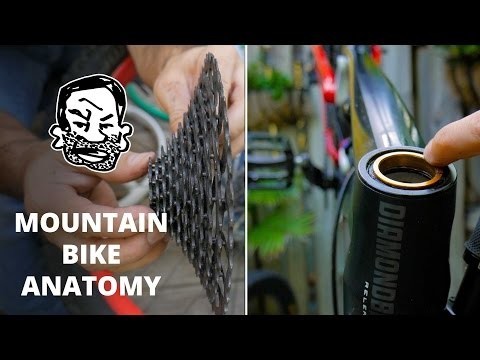bicycle repair … | Mountain Bike Anatomy - 50 parts in 5 minutes
본문
※ 영상을 선명하게 보기 안내
- 유튜브 영상에서 오른쪽하단에 톱니바퀴를 클릭합니다.
- 팝업목록에서 "품질" 선택하세요.
- 원하는 해상도를 선택해주세요.
※ 모바일에서 Wifi가 아니라면 데이타가 소진될 수 있으니 주의바랍니다.
bicycle repair …님의 Bicycle Repair Tips강의 청각장애인을 위한 자막

This is a mountain bike, and at the heart
of any bike is its frame.
Let’s start with the parts of the frame.
This here is the top tube, the down tube,
the seat tube, the seat stay, and the chain
stay.
This area down here is called the bottom bracket
shell.
At the very front of your bike is the head
tube, which houses the steerer tube.
This moves smoothly thanks to a set of cups
and bearings collectively known as the headset.
Above that are headset spacers and the stem.
The stem, which clamps on to your handlebars,
is fastened to the steerer tube with a top
cap and pinch bolts.
On your handlebars you’ll find brake levers,
shifters, grips, and end plugs.
All this stuff up here is collectively known
as the cockpit.
Moving down is your fork, which in this case
is a suspension fork.
This top piece is called a crown.
Some bikes are fitted with dual crown forks
for added strength.
The crown is what holds your stanchions, which
you should try as hard as possible not to
scratch.
Don’t hang your bike by the stanchions.
Down here is your brake caliper, which camps
down on your rotor when you squeeze your brake
lever.
Some calipers are mechanical, while others
are hydraulic.
Hydraulic brakes push fluid through a hose,
while mechanical brakes pull the caliper using
a cable.
This big round thing is a wheel.
If you buy a front and back wheel together,
it’s called a wheelset.
All the parts of your wheels are held together
using spokes, which connect to your rim with
these little guys.
They’re called nipples.
Also on the rim is a valve stem which is used
for pumping air into your tires.
At the center of the wheel is the hub, and
inside the hub are bearings.
The hub rotates around an axle.
On a lot of mountain bikes this takes the
form of a thru axle, which can be removed
or installed by hand.
On the rear wheel a cassette hub.
This has a ratcheting mechanism built into
it which is made to accept a cassette.
The cassette is a set of cogs which can actually
be changed to your liking.
The size of each cog is measured by the number
of teeth it has, and these teeth are specially
designed to work with a chain.
Your chain is made up of individual links,
with one link in particular being possible
to unfasten easily.
This is called a master link.
The chain can be shifted up and down the cassette
with a derailleur, which is attached to the
bike via a small breakable part called a derailleur
hanger.
If your derailleur hanger snaps or bends,
you can just get a new one.
On the derailleur itself is a long spring
loaded piece called the cage, which keeps
tension on the chain.
The chain passes through the upper pulley
and lower pulley, also known as the jockey
and idler respectively.
Moving down to the bottom bracket shell, you’ll
find your crankset, with the most visible
parts being the crank arms.
The crank arms are attached to the spindle,
which runs through a set of bearings which
are inside the bottom bracket shell.
The spindle and bearings collectively are
known as the bottom bracket.
The part with all the teeth is called the
chainring.
Some bikes have up to 3 of these.
At the end of the crank arms are pedals, which
can be found in many different forms.
The crankset, chain, derailleur and cassette
are collectively known as your drivetrain.
On a full suspension mountain bike you’ll
find a variety of stuff connecting the front
and rear of the bike together, known as the
suspension linkage.
At the heart of all this is your shock.
This is usually fastened to the linkage on
one side, and to your top tube or down tube
on the other.
Moving up, we have the seat, or saddle.
The two words are interchangeable, but some
people think it’s pretentious to call it
a saddle.
Personally I don’t care what you call it
as long as you don’t correct other people.
In any case this is most definitely not a
saddle post, it’s a seat post, and it’s
held on to your bike with a seat post clamp,
or collar.
These days a lot of seat posts can be adjusted
on the fly.
Those are called dropper posts.
So I just named well over 50 parts of a mountain
bike, but all of these parts can be broken
down into hundreds more.
So, put those terms down in the comments,
and if you’re really bored see if you can
come up with an exact count of the terms I
used in this video.
Also, tell me how you pronounce derailleur.
Are you one of those people who say “derailleeyur?”.
In any case thanks for riding with me today,
I’ll see you next time.


댓글 0개
등록된 댓글이 없습니다.